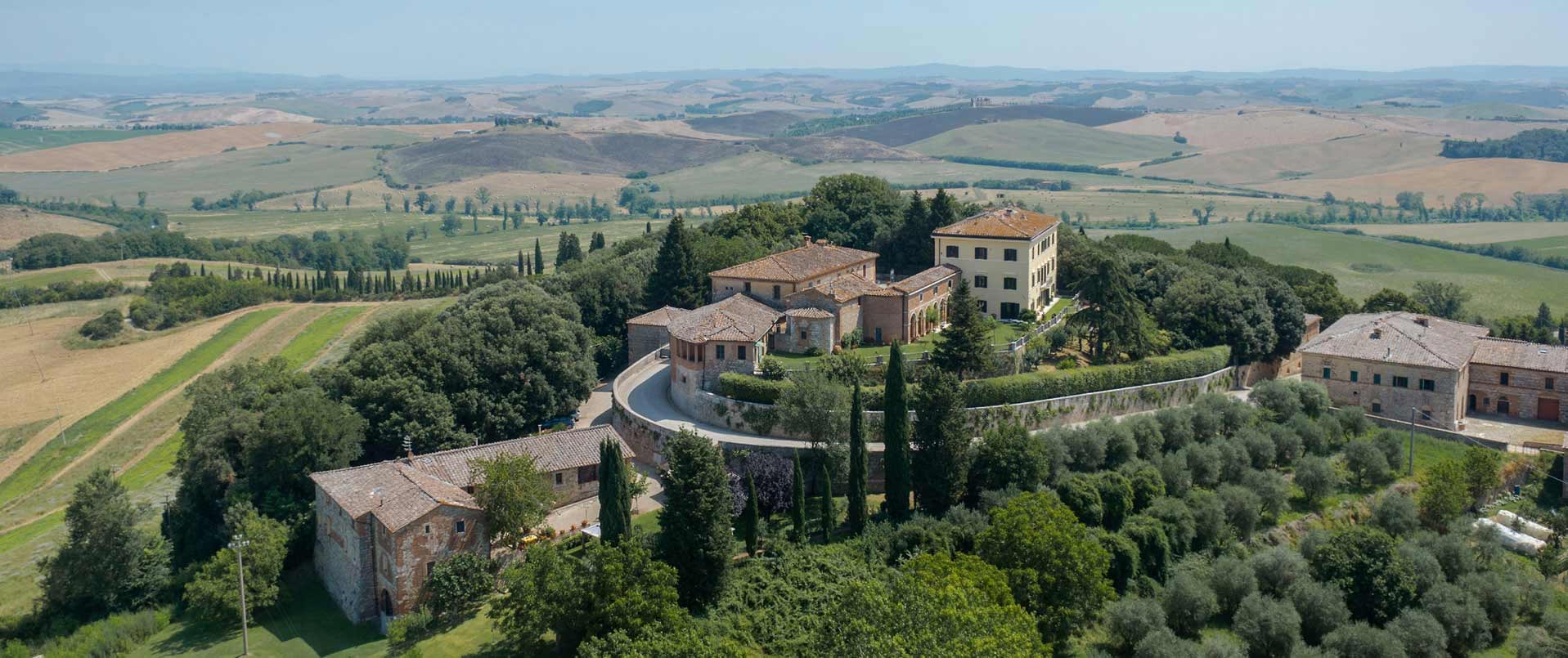
The Rocca d’Ajello is an ancient fortress that was built between 1260 and 1450 by the ducal family of Varano, who ruled Camerino from the 13th to the 16th century. It stands on a hill cloaked in woods, surrounded by an unspoiled hilly landscape in which fields and vineyards stretch as far as the eye can see, creating a kaleidoscope of ever-changing colours across the different seasons.
Right in front of the Castle is the Church of San Biagio (dedicated to Saint Blaise), which was constructed on the ruins of a 10th-century abbey, along with its old rectory. The entire hill on which the castle stands has become an intensively cultivated garden that houses a collection of ancient and modern roses, as well as a host of colourful dahlias. There is not a single corner where flowers do not grace the otherwise severe medieval architecture with their exuberant blooms and vibrant hues. Climbing roses scale the oaks, cascading in delicate festoons, covering the walls of the castle and the rectory, framing the white cloud-like portal of the Church of San Biagio from which the bride and groom duly emerge, amidst the obligatory shower of rice grains to wish them well in their married life.
To access the Castle, guests can take the steps in the Orchard Garden, which is edged with flowers and shrubs in varying shades of yellow, blue and white. Climbing roses in various gradations of yellow clothe the old fruit trees along the terraces. At the far end, bordering cultivated fields, there is a collection of cut roses grouped by colour, used by the Rocca’s florists to create large bouquets in the halls of the residence and for decorations at many different types of events.
For those who prefer not to climb up the hundred steps from the Orchard, an alley bordered with flowers leads directly to the garden located along the main façade of the castle. Encircled by crenellated walls, it has an Italian-style layout. There are six large flowerbeds framed with boxwood and overflowing with flowers, with a stone basin in the centre filled with water lilies and two romantic arches covered with roses and clematis. It is here that the aperitif is served during events and receptions.
The residence is spread over several levels, given the unique configuration of the area on which it stands. At the lower level, we find the grand medieval sandstone halls with their vaulted ceilings, which is where the private events are hosted. There is an ancient stable (the Horseguards Hall) still containing the niches in which the Varano garrison’s horses used to be fed and an entrance hall, with the Armoury Hall situated on a higher level. Ascending further, guests step into the large courtyard enclosed within the castle walls, overlooked by a room filled with games for children to enjoy.
On the ‘piano nobile’ first floor, there is a series of furnished lounges, many featuring frescoed ceilings, which house a collection of works by engraver and painter Francesco Vitalini, the landscape artist who lived here between 1865 and 1905.
The history of castello di Rocca D’Ajello
Between 1260 and 1280, Gentile I da Varano, the Lord of Camerino, commissioned the building of the two towers of the Rocca d’Ajello, its name possibly being derived from the word ‘agellus’, meaning ‘little field’. These were observation towers, undoubtedly much taller than they are today, which were used for optical communication with other fortresses in the region and for monitoring the nearby Potenza River, the Palente basin and the gorge that led to Torre Beregna, also known as “Troncapassi”. The two fortified units were connected by an underground tunnel and, as they were built at close range, any potential attacker would be exposed to crossfire in the jointly guarded area.
In 1382, Giovanni da Varano, known as ‘Spaccaferro’, or the Iron Splitter, constructed a defensive line that stretched for some 12 kilometres from Torre Beregna, a tower which has recently collapsed, to the mouth of the Pioraco Gap, in order to counter the expansionist ambitions of Matelica and San Severino. This line included the two towers of Rocca d’Ajello, Torre del Parco (also known as “Salvum me fac”, “Torre dei Bilancioni” or “Torre del Ponte” because it defended the bridge over the Potenza River), Lanciano Castle (later transformed into a splendid villa with a large park by Giovanna Malatesta, wife of Giulio Cesare Varano, in the late 15th century), and the Torre Porta di Ferro tower in Pioraco, which no longer exists.
The line’s defences consisted of ditches, embankments and a kind of ‘cheval de frise’, a defensive obstacle used in warfare with projecting spears or spikes, which required the felling of a significant number of trees for its construction, resulting in the term “Tagliata” or “Intagliata” (cut-out). It was Giovanni da Varano (1377) who initiated the transformation of the fortress, which was completed in 1475 by Giulio Cesare Da Varano, whose initials can be seen in a fragment of a fresco in the Armoury, with the creation of a fortified complex with a trapezoidal layout, that included living quarters.
In the inventory of the assets of the Varano family, compiled in 1502 by Cesare Borgia who had seized the State of Camerino, Ajello is defined as a “Villa con Rocca” or ‘Villa with a Fortress’.
After the end of the Varano rule in the mid-1500s, the Castle came under the authority of the Papal States and subsequently passed through different families including the Massei and the Bruschetti. In the middle of the 19th century, it was acquired by Ortenzio Vitalini. His descendants are still the present owners.
The church of San Biagio, located in front of the Castle, stands on the remains of a monastic settlement founded in the ninth century, which was affiliated with the Abbey of Sassovivo in Foligno. In the apse, there is a fresco depicting Christ on the Cross surrounded by Mary, St. John and Bishop San Biagio. It is dated 1523 and is the work of a painter of the school of Girolamo di Giovanni.
Facilities and services: weddings and private events in the Marche region.
Rocca d’Ajello Castle can be rented for a variety of occasions: weddings and other ceremonies (baptisms, communions, confirmations), graduation parties, birthdays and anniversaries, and corporate events. The residence offers spacious indoor and outdoor areas, including a vast flower garden, a large paved courtyard surrounded by crenellated walls, the air-conditioned Armoury and the Varano Horseguards Hall, two large halls each of which can accommodate up to 220 seated guests, and the Carriage Hall, where another 50 or so people can be seated. All rooms are heated.
The elegantly furnished drawing rooms on the ‘piano nobile’ floor, adorned with striking bouquets of flowers picked in the gardens of the Rocca, provide a graceful backdrop for bride and groom’s photos and can be visited by guests. There is also a nursery full of toys to entertain the younger guests. The entire venue is exclusively rented to one couple per day, allowing them to choose their preferred caterer or restaurant.
The kitchens are equipped with industrial appliances and centralised gas. The facilities provided by the venue include rectangular tables, round tables in three sizes, Thonet-style chairs for the halls, and seating and side tables for the garden. Additional services offered by the Castle include floral decorations, candlelit illumination of the halls and torch lighting for the exteriors.
Former home of the Parish Priests of the Church of St. Blaise in Rocca d’Ajello, the ‘Canonica’ Rectory is a country house located directly in front of the Castle. Furnished with period furniture and equipped with Wi-Fi, it comprises a living room, two double bedrooms, one single bedroom, a bathroom and a large, fully equipped, eat-in kitchen. The living room’s sofa beds can accommodate three people, bringing the total number of beds available to 8. Everything needed for breakfast is also provided.
Activities at Castello di Rocca D’Ajello
Places of interest in the vicinity
Parks: Among the best known are the National Park of the Sybilline Mountains, Fiastra Abbey Nature Reserve, Conero Park, the Frasassi Caves and many more.
Cities of Art: Camerino, San Severino, Matelica, Fabriano, Tolentino, Macerata.
Villages: Some of the most beautiful villages in the Macerata province are Cingoli, Esanatoglia, San Ginesio, Sarnano, Montecassiano, Belforte del Chienti, Treia, Gagliole and Fiordimonte.
 Accommodation
Accommodation
 Co-Working
Co-Working
 Film sets
Film sets
 Gardens
Gardens
 Medium and long-term rentals
Medium and long-term rentals
 Pet Friendly
Pet Friendly
 Private events
Private events
 Visits
Visits
 Weddings
Weddings
 Cultural tourism
Cultural tourism  Cyclotourism
Cyclotourism  Excursions
Excursions  Gardens
Gardens  Hiking
Hiking  Nature
Nature  Restaurants
Restaurants  Sports
Sports  Walking itineraries
Walking itineraries  Wine tourism
Wine tourism